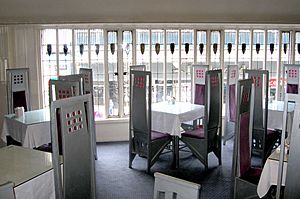Charles Rennie Mackintosh facts for kids
Quick facts for kids
Charles Rennie Mackintosh
|
|
|---|---|
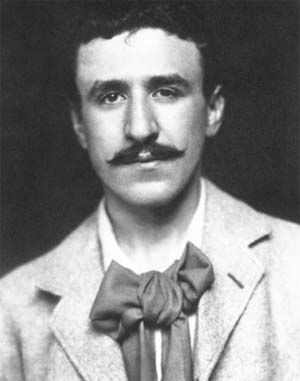 |
|
| Born |
Charles Rennie McIntosh
7 June 1868 |
| Died | 10 December 1928 (aged 60) |
| Nationality | Scottish |
| Education | Glasgow School of Art |
| Known for | Architecture, Art, Design, Decorative Arts |
|
Notable work
|
Glasgow School of Art, The Willow Tearooms, Hill House, Queen's Cross Church, Scotland Street School |
| Style | Symbolism, Arts and Crafts, Art Nouveau, Glasgow Style |
| Movement | Glasgow Style, Art Nouveau, Symbolism |
| Spouse(s) | Margaret Macdonald Mackintosh |
Charles Rennie Mackintosh (born June 7, 1868 – died December 10, 1928) was a famous Scottish architect, designer, and artist. He was known for his unique style, which mixed art with everyday objects. His work, along with his wife Margaret Macdonald, greatly influenced art movements like Art Nouveau in Europe. Mackintosh was born in Glasgow and passed away in London. He is considered one of the most important figures of the "Modern Style" in British art.
Contents
Early Life and Education
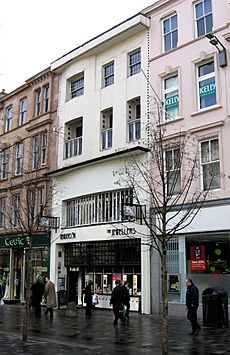
Charles Rennie Mackintosh was born in Townhead, Glasgow, on June 7, 1868. He was the fourth of eleven children. His father, William McIntosh, worked for the City of Glasgow Police.
Charles went to Reid's Public School and Allan Glen's Institution from 1880 to 1883. His mother, Margaret Mackintosh, grew up in Glasgow.
About His Name
Around 1893, Charles changed the spelling of his last name from 'McIntosh' to 'Mackintosh'. His father had also done this before him.
Sometimes people mistakenly call him 'Rennie Mackintosh'. However, 'Rennie' was his middle name, taken from his mother's maiden name. He often used it when signing his work. He should be called "Charles Rennie Mackintosh" or simply "Mackintosh." His friends and family sometimes called him 'Toshie'.
Career and Family Life
In 1884, Mackintosh began his journey in architecture. He became an apprentice to John Hutchinson in Glasgow. In the evenings, he studied at the Glasgow School of Art, where he won many awards.
In 1889, he joined a big architectural firm called Honeyman and Keppie. He worked there as a draughtsman and designer. By 1901, he became a partner in the company.
Around 1892, Mackintosh met Margaret Macdonald at the Glasgow School of Art. She was also an artist. The head of the art school, Francis Henry Newbery, introduced Charles and his friend Herbert MacNair to Margaret and her sister Frances MacDonald. He saw that their artistic styles were similar.
Margaret and Charles got married on August 22, 1900. They did not have any children. Herbert MacNair and Frances also married the year before. These four artists worked together and became known as "The Four." They were very important in the Glasgow Style of art and design.
After marrying, Charles and Margaret lived in Mains Street in Glasgow. Later, they moved to Southpark Avenue, near Glasgow University.
Around 1913, Mackintosh left the architectural firm. He tried to start his own business.
Design Ideas and Influences
Mackintosh spent most of his life in Glasgow, a city known for its shipbuilding and engineering during the Industrial Revolution. As Glasgow grew, there was a need for new designs and products.
Mackintosh's designs were also influenced by Japanese art. When Japan opened up to the world, its art became very popular in the West. Glasgow had strong ties with Japan because of its shipyards. Japanese design was admired for its simplicity and natural materials. It focused on creating a calm and organic feeling in a space.
At the same time, new "modernist ideas" were appearing in Europe. This movement focused on creating useful and practical designs, looking to the future instead of history. Mackintosh was seen as a leader in this movement. However, his designs were not just practical. He wanted to create art that met the needs of individuals, not just machines for living.
Mackintosh combined his Scottish background with the flowing lines of Art Nouveau and the simplicity of Japanese art. His unique style often featured strong straight lines mixed with floral patterns and gentle curves, like his famous "Mackintosh Rose." He also included elements from traditional Scottish architecture.
One of his most famous projects was the Glasgow School of Art (1897–1909). He also designed the Queen's Cross Church in Glasgow. This is the only church he designed that was built, and it is now the home of the Charles Rennie Mackintosh Society.
Like his friend Frank Lloyd Wright, Mackintosh often designed every detail of his buildings, including the furniture and decorations. His wife, Margaret Macdonald, helped a lot with these details and drawings. Their work was shown at an important art exhibition in Vienna in 1900.
Mackintosh's career as an architect was short but very impactful. Most of his major projects were built between 1895 and 1906. These included homes, commercial buildings, and churches.
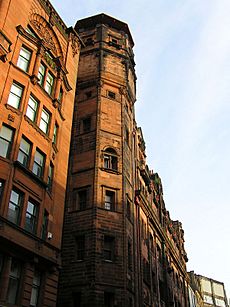
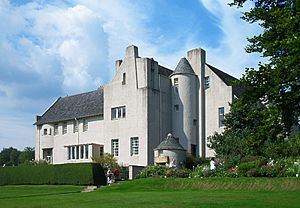
Some of his well-known works include:
- Hill House, Helensburgh: This house is one of the few places where you can see Mackintosh's complete designs, including the furniture and fittings.
- The Willow Tearooms, Sauchiehall Street, Glasgow: Designed for Catherine Cranston.
- Former Daily Record offices, Glasgow.
- Former Glasgow Herald offices, now The Lighthouse – Scotland's Centre for Design and Architecture.
- 78 Derngate, Northampton: He designed the interior and remodeled this home.
Designs That Were Not Built
Many of Mackintosh's bigger designs were never built. For example, his plans for the 1901 Glasgow International Exhibition were not constructed. His "Haus eines Kunstfreundes" (House for an Art Lover) from the same year was also not built at the time. He also entered a competition to design Liverpool Cathedral in 1903 but did not win.
Even though his architectural output was small, Mackintosh greatly influenced design in Europe. His work was popular in Austria and Germany, especially after being shown at the Vienna Secession Exhibition in 1900.
Other Design Work and Paintings
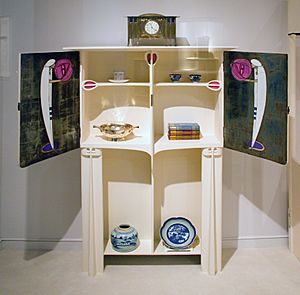
"The Four" – Mackintosh, Margaret Macdonald, Frances MacDonald, and Herbert MacNair – became famous as "The Glasgow Four." They were important members of the "Glasgow School" art movement. Their work was shown in Glasgow, London, and Vienna, which helped Mackintosh become well-known. The "Glasgow" style influenced the Art Nouveau movement in Vienna around 1900.
Mackintosh also worked on interior design, furniture, textiles, and metalwork. Much of this work combined his designs with those of his wife, Margaret. Her flowing, floral style went well with his more structured designs.
Later Life
Later in his life, Mackintosh became less interested in architecture. He focused more on painting watercolors, especially landscapes and flowers. He often worked with Margaret, and their painting styles gradually became very similar.
In 1914, they moved to the village of Walberswick in Suffolk, England. During World War I, Mackintosh was wrongly suspected of being a German spy and was briefly arrested in 1915.
By 1923, the Mackintoshes moved to Port Vendres, a coastal town in southern France. It had a warm climate and was cheaper to live there. Mackintosh completely stopped working on architecture and design. He spent his time painting watercolors of landscapes and buildings. Many of his paintings show Port Vendres and the beautiful areas around it.
The couple had to return to London in 1927 because of his illness. That year, Charles Rennie Mackintosh was diagnosed with tongue cancer and throat cancer. He passed away on December 10, 1928, at the age of 60. His body was cremated, and his ashes were scattered over the Mediterranean Sea at Port Vendres, as he wished.
His Legacy
Mackintosh's work became even more popular after his death. Some of his designs that were never built have since been constructed.
- The Mackintosh House (1981) is a special building that holds the reconstructed rooms of the Mackintoshes' former Glasgow home. It is part of the University of Glasgow's Hunterian Museum and Art Gallery, which has the world's largest collection of Mackintosh's work.
- The Artist's Cottage (1992) and two gatehouses (1995-1997) were built near Inverness, based on his unbuilt designs from 1901.
- The House for an Art Lover was built in Glasgow's Bellahouston Park in 1996, based on a design competition entry by Mackintosh and Macdonald from 1901.
The Glasgow School of Art building, also known as "The Mackintosh Building," is considered one of the best buildings in the UK. Sadly, it was badly damaged by fires in 2014 and 2018. There are plans to rebuild it faithfully.
The Charles Rennie Mackintosh Society works to teach people more about Mackintosh's work. His popularity grew when Glasgow was named the European Capital of Culture in 1990, and an exhibition of his work was held. This led to many of his neglected buildings being restored and opened to the public. For example, the Scotland Street School Museum opened in 1990, and 78 Derngate opened in 2003. The Willow Tearooms reopened in 2018 after a big restoration.
In 1996, the Metropolitan Museum of Art in New York City held a major exhibition of his works.
Charles Rennie Mackintosh was honored on banknotes issued by the Clydesdale Bank in 2009. His image appeared on £100 notes.
In 2015, it was announced that Mackintosh's designs for a tearoom would be rebuilt for the new V&A museum in Dundee. The original building was torn down in 1971, but the interior pieces had been saved. The restored "Oak Room" was revealed when V&A Dundee opened in 2018.
In June 2018, a mural showing Mackintosh and his unique style was created in Glasgow to celebrate his 150th birthday.
See also
 In Spanish: Charles Rennie Mackintosh para niños
In Spanish: Charles Rennie Mackintosh para niños
- The English House
- People on Scottish banknotes


